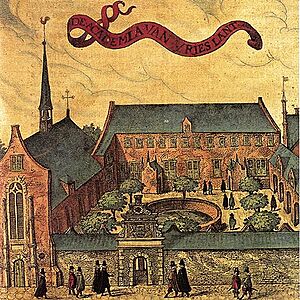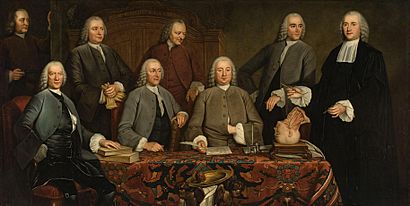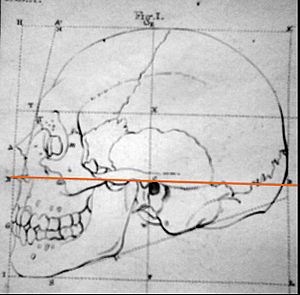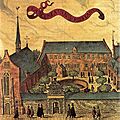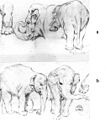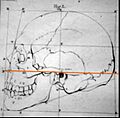Petrus Camper facts for kids
Quick facts for kids
Petrus Camper
|
|
|---|---|
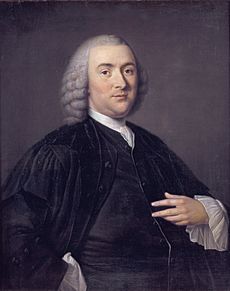
Petrus Camper
|
|
| Born | 11 May 1722 |
| Died | 7 April 1789 (aged 66) |
| Nationality | Dutch |
| Alma mater | University of Leiden, Oxford College |
| Known for | inventing the term "extinct" along with Georges Cuvier to describe the mammoth |
| Scientific career | |
| Fields | anatomist physiologist philosopher surgeon (dissection) Draughtsman |
| Institutions | University of Franeker, Amsterdamse Atheneum, University of Groningen |
| Doctoral students | Martin van Marum |
Petrus Camper (born May 11, 1722 – died April 7, 1789) was a famous Dutch scientist. He was a doctor, an anatomist (someone who studies the body's structure), and a physiologist (someone who studies how the body works). He also worked as a surgeon, a zoologist (animal expert), and an anthropologist (someone who studies humans).
Camper lived during the Age of Enlightenment, a time when people focused on science and reason. He was one of the first to study comparative anatomy, which means comparing the bodies of different animals. He also looked into palaeontology (the study of fossils) and something called the "facial angle." He helped create the field of "anthropology," which is the study of humans. He even studied animals like the orangutan and the Javan rhinoceros. He also looked at the skull of a mosasaur, which is an ancient sea reptile.
Petrus Camper was very well-known across Europe. He became a member of many important science groups, like the Royal Society in London. He also designed special tools for his patients and for surgeries. Camper was a talented artist, a sculptor, and someone who supported other artists. He was also involved in politics. Camper wrote about his methods for measuring skulls, which helped future scientists.
Contents
Studies and Early Career
Petrus Camper came from a wealthy family. His father was a minister who made money in Batavia, Dutch East Indies. Camper was a very smart student. He studied medicine and philosophy at the University of Leiden. He earned degrees in both subjects on the same day when he was 24 years old.
After his parents passed away, Camper traveled a lot. He visited England, where he met a famous doctor named William Smellie. He also went to France and Switzerland. While he was traveling, he was offered a job as a professor. He taught philosophy, anatomy, and surgery at the University of Franeker in the Netherlands.
In 1756, Camper married Johanna Boerboom. She was the daughter of the mayor of Leeuwarden.
Work as a Surgeon and Scientist
In 1755, Camper moved to Amsterdam. There, he became a professor of anatomy and surgery at the Athenaeum Illustre of Amsterdam. He later also taught medicine. He studied different health problems, like inguinal hernia (a type of bulge in the groin) and issues with the patella (kneecap). He even researched the best shape for shoes!
Five years later, he decided to focus only on his scientific research. He lived on his wife's estate. In a speech, he said he had publicly dissected (carefully cut open and studied) over 50 bodies. This experience helped him write a book called Demonstrationum anatomico-pathologicarum. In 1762, he became involved in public health. He promoted vaccination to protect people from smallpox, a dangerous disease.
In 1763, he accepted a new job at the University of Groningen. He taught anatomy, surgery, and botany there. He drew many pictures to help explain his lectures, and more and more students came to learn from him.
Key Scientific Discoveries

Camper focused a lot on anatomy, zoology, and his collection of rocks and fossils. He studied the bones of birds and found that birds have air inside their bones. This helps them fly. He also studied eight young orangutans. He proved that orangutans are a different species from humans and walk on all fours, unlike some scientists at the time believed. Camper helped clear up confusion by showing the difference between orangutans and chimpanzees.
He also wrote about how fish hear and how frogs make sounds. He studied diseases like rinderpest (a cattle disease) and rabies. Camper also ran a surgery clinic. Before he retired in 1773, he introduced new tools and ways of doing surgery and helping with childbirth. Back in Franeker, he dissected an elephant and a Javan rhinoceros that had died in the menagerie (a private zoo) of the stadtholder (a Dutch leader). In 1782, he published his latest research. In it, he disagreed with other famous scientists like Carl Linnaeus about how to group different types of apes.
- In 1778, another scientist named Samuel Thomas von Sömmering visited him. Camper also knew Johann Friedrich Blumenbach.
- In 1780, he traveled with his son and met important people like Frederick the Great, the King of Prussia.
- In 1783, he became a founding member of the Royal Society of Edinburgh.
- He was also involved in local politics, becoming a mayor and a director of the navy.
- In 1787, he became the president of the Dutch Council of State, a very important government position.
Comparative Anatomy

Petrus Camper was one of the first to study comparative anatomy. He showed how all living things are connected by a basic plan. In a lecture from 1778, he showed how a horse could be "changed" into a human. This helped explain that all vertebrates (animals with backbones) have similar body structures.
This idea, called the "unity of organic composition," meant that nature uses one basic design, but changes it for different animals. Camper's ideas greatly impressed other famous thinkers like Denis Diderot and Johann Wolfgang Goethe. Some people even think Camper's work helped lead to Goethe's idea of a "type" – a common structural pattern found in many animals.
The "Facial Angle"
Petrus Camper is well-known for his theory of the facial angle. This was a way he measured faces. He said that humans have facial angles between 70 and 80 degrees. He believed that people from Africa and Asia had angles closer to 70 degrees, while Europeans had angles closer to 80 degrees.
To find this angle, he drew two lines on a face. One line went from the nostril to the ear. The other line went from the front of the upper jawbone to the most prominent part of the forehead. He claimed that ancient Greek and Roman statues had an angle of 95-100 degrees. He said Europeans had 80 degrees, 'Orientals' had 70 degrees, and Black people had 70 degrees. He also measured orangutans at 42-58 degrees.
Camper believed that, based on these angles, Africans were furthest from what he considered the "ideal beauty" of classical statues. Sadly, these ideas were later used to support scientific racism, which is a harmful and incorrect belief that one race is better than another.
However, Camper did agree with another scientist, Buffon, that there was a clear difference between humans and animals. He also supported the way Carl Linnaeus grouped different species of living things.
Camper and Art
Camper was interested in many things, including architecture, mathematics, furniture making, and drawing. He often drew pictures for his own lectures. He gave lectures to art students in Amsterdam about beauty and portraiture (painting portraits). He disagreed with artists who painted the black Magus (one of the wise men in the Christmas story) with a European face.
He took lessons from a sculptor named Étienne Maurice Falconet. Camper's ideas about art were influenced by Johann Joachim Winckelmann, another important art historian. He also drew pictures of ancient stone monuments called Dolmen. He was even on a committee that chose the design for the new town hall in Groningen.
Legacy
Another famous scientist, Georges Cuvier, praised Camper's "genius eye." Camper was honored with special speeches by important thinkers like Nicolas de Condorcet. His work also influenced other scientists like Louis-Jean-Marie Daubenton.
Camper's son, Adriaan Gilles Camper, published many of his father's scientific papers that had not been released yet. He also wrote a biography about his father.
The Dutch writer Thomas Rosenboom even used Petrus Camper as a character in his novel, Gewassen vlees (1994).
Petrus Camper was elected to the American Philosophical Society in 1789, a group that promotes useful knowledge.
Works
- Demonstrationes anatomico- pathologicae (1760–1762)
- Dissertation sur les différences des traits du visage (Dissertation on the differences in facial features)
- On the Best Form of Shoe
- Two lectures to the Amsterdam Drawing society on the facial angle (1770)
- On the Points of Similarity between the Human Species, Quadrupeds, Birds, and Fish; with Rules for Drawing, founded on this Similarity (1778)
- Works by Petrus Camper, a collection of his work published after his death by his son and Hendrik Jansen in 1803.
Images for kids
-
The Indian Elephants Hans and Parki from the menagerie of Stadholder Willem V. Camper studied animals like these.
-
Camper studied fossils like this Mosasaurus jawbone from Maastricht.
See also
 In Spanish: Petrus Camper para niños
In Spanish: Petrus Camper para niños


